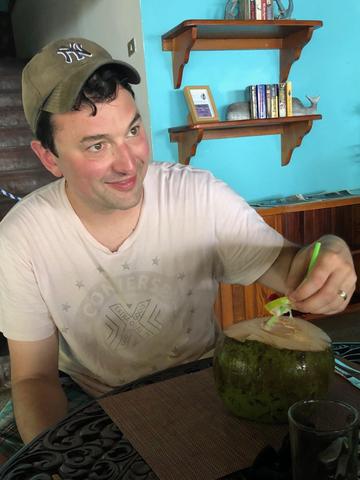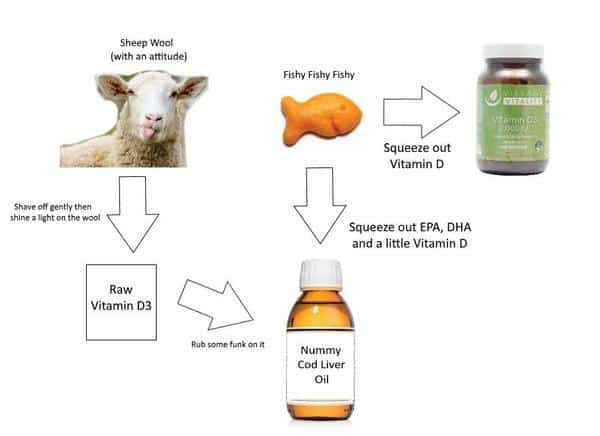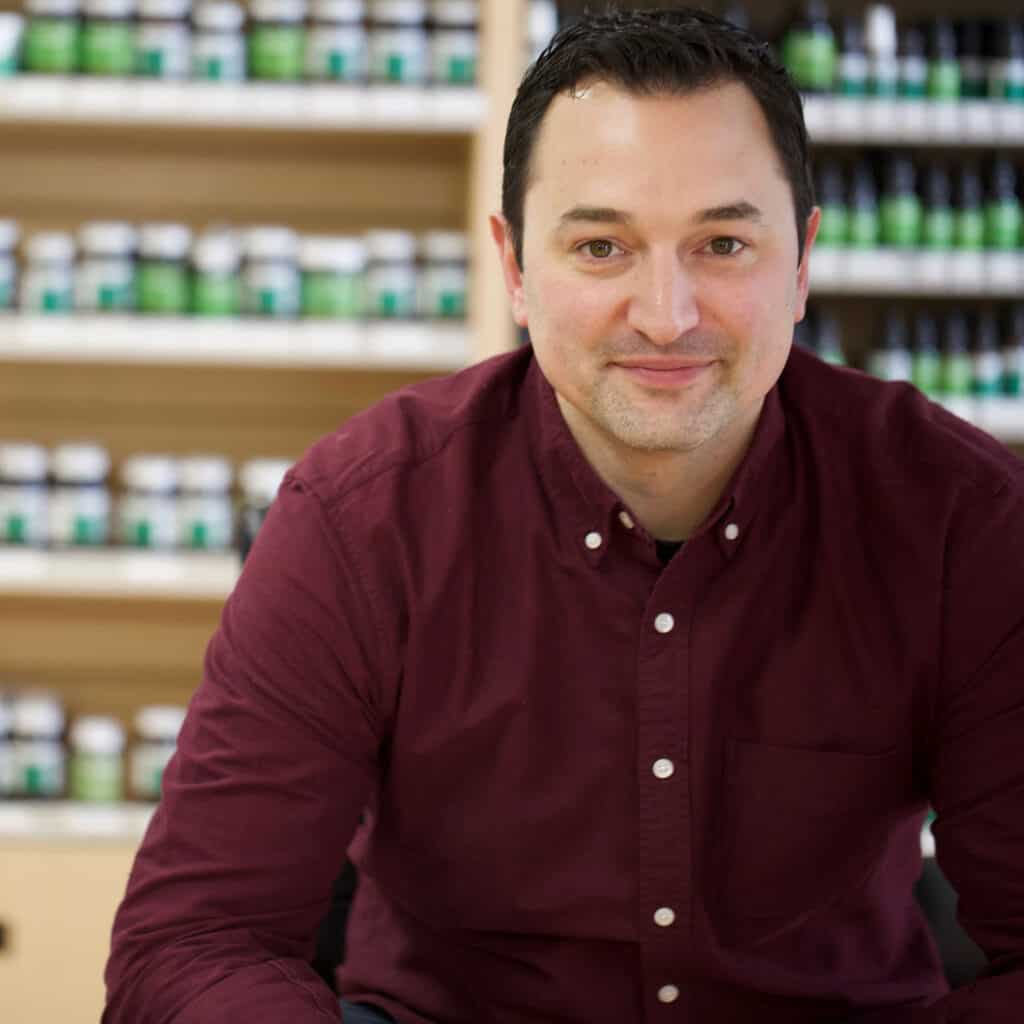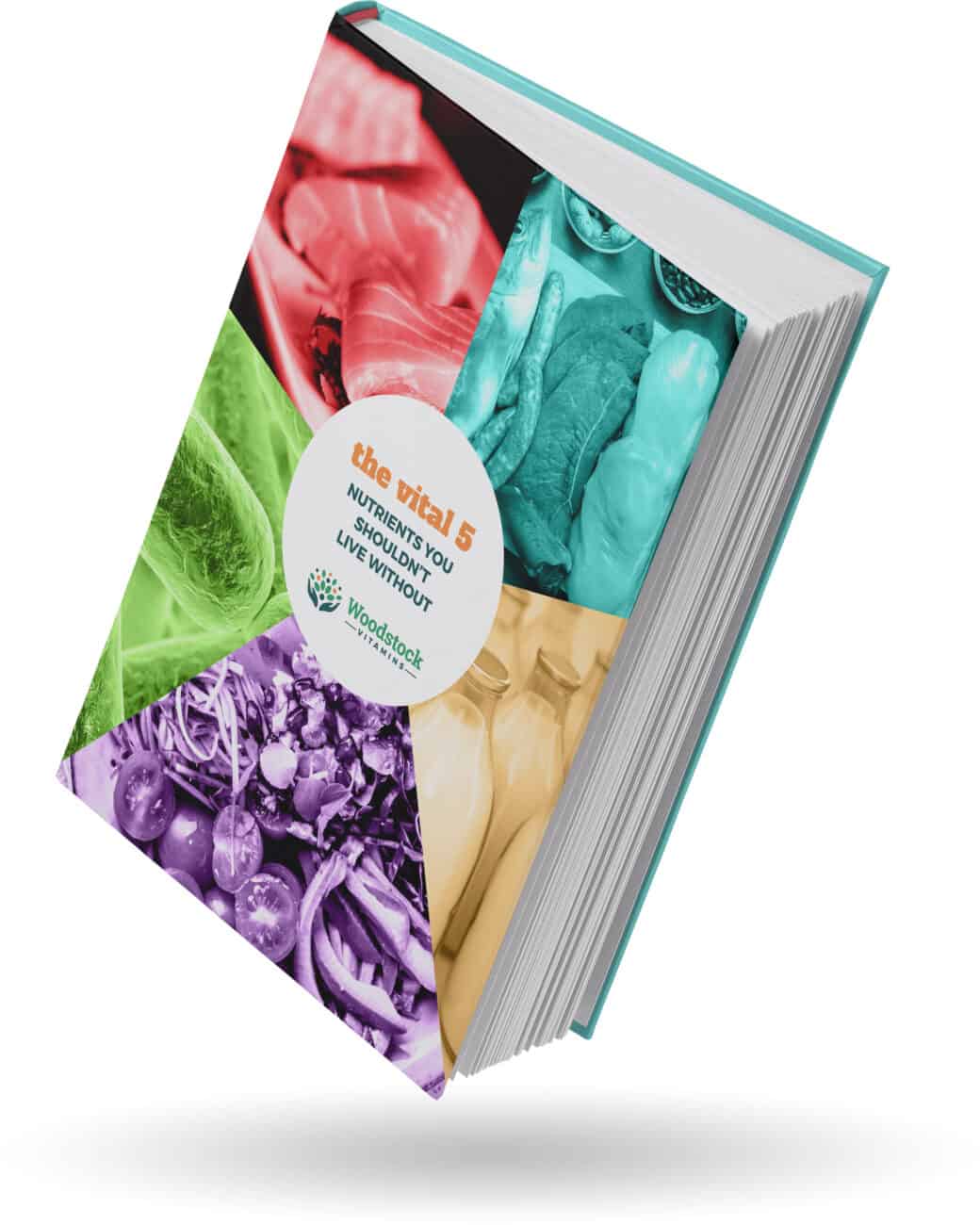My favorite thing to tell people about Vitamin D is that Vitamin D isn’t what we think it is.
Specifically, it’s not a vitamin. It’s a hormone.
A vitamin is defined as a chemical we need for body processes that come from the diet, since we can’t synthesize it on our own. Vitamin D, though, is made by the body. Specifically, the skin contains a Vitamin D precursor that is activated by sun exposure. When one organ of the body creates a compound that is transported via the blood to other organs where it acts to increase or decrease that organ’s function, we call that compound a hormone.
The reason we believe it’s a vitamin is because we discovered the compound, the story goes, first from a disease of deficiency. If we remember our Garden of Lies article, we discussed how most vitamins were discovered (and are best served) by curing diseases of deficiency. Vitamin D deficiency caused rickets, and replacing the vitamin cured the disease. Chicken or the egg. Vitamin or the hormone. Either way, it’s always been there and we’re the ones coming up with these silly names.
“If it’s not a vitamin, but a hormone that we make, how can we have a disease of deficiency?” The same problem from then still happens now, and why we are Vitamin D connoisseurs this day and age: poor diets and limited sun exposure means not enough activated and useful Vitamin D in some people. Most of us CAN go without Vitamin D from diets or supplements, but lots of factors make it so we need to get Vitamin D from external sources, and not just rely on the sun. (I’m sure this ability to get Vitamin D either way is probably some evolutionary response to us moving to colder areas with less intense sunlight.)
My second favorite thing to tell people about Vitamin D is that it isn’t just one thing. Most of us know there are two forms of Vitamin D – Vitamin D2 and D3. We’ll dive into the differences a bit later. In reality, there are Vitamin D1-D5 (which in reality are just slight variations of D2 and D3), plus all the different “activated” stages of Vitamin D. When we say Vitamin D, we mean every and all of them. In medicine, we usually get pretty specific when discussing it, but for consumers, Vitamin D normally either means the D2, D3, or the final, active form.
My third favorite thing to tell people about Vitamin D is that this picture is awesome:

Following from top to bottom, the sun activates a chemical in the skin (7-de-hydro-cholesterol) and turns it into our friend, Vitamin D3. Also, Vitamin D2 and D3 can come from our diet. Regardless of how D3 gets into you, it needs lots of “encouragement” along the way.
The coolest thing, from a nerd’s opinion, is that it requires 2 separate organs to turn Vitamin D into its active state. The uncool thing: if you have severe liver or kidney disease, you probably aren’t going to be doing a great job converting it at all. Some patients will have to take the final, active form, which is available as a prescription called calcitriol.
What Does Vitamin D Do?
Our body keeps tight control over blood levels of calcium. It rarely gets too low or high. If it does, you’ll be in the hospital in no time under close watch. The body does so using numerous hormones (calcitonin, parathyroid hormone), which tells the GI tract to absorb more or less dietary calcium, the kidneys to pee out more or less calcium, and most importantly, the bones to store more or less calcium. If we don’t maintain adequate dietary calcium intake, our bones will be robbed of their density to keep blood calcium levels normal. And 70% of women over 20 don’t do that, for example.
The role of vitamin D is to help maintain calcium levels in the blood by increasing the absorption of calcium in the GI tract.
That’s it. What we think or feel about Vitamin D is that it’s some magical thing that has all these roles in the body. Or that it itself magically heals bones. In reality, all Vitamin D does is help the gut get more calcium into the blood from the diet. Kinda boring.
There are some roles Vitamin D occupies in the immune system and with other metabolic functions, sure.
But if you ask some “gurus” about all the things Vitamin D can do, they’ll make claims for benefits for heart disease, cancer risk, diabetes, and depression. There has been no definitive data found to support those claims, with even larger trials concluding in the upcoming months. We’ll know more as we study more, but for right now, Vitamin D helps best for preventing falls in the elderly and fracture prevention in specific, at-risk populations. We’ll speak more on this later.
The Two Types of Vitamin D
“I thought you said there were like 5 types of Vitamin D?” I did, but we only really care about two. Vitamin D2 and Vitamin D3.
Vitamin D2 is the form of vitamin D that comes from plants. Specifically lichen, mushrooms, fungus, and plants like alfalfa. Vitamin D2 is less bioavailable and does not sustain vitamin D levels in the blood as well as Vitamin D3.
Vitamin D3 is the form of Vitamin D that comes from animal sources. Specifically fatty fish, beef liver, and eggs. It is far more bioavailable than D2 and sustains Vitamin D levels in the blood to a greater degree than Vitamin D2.
“Why would anyone use Vitamin D2?” Vitamin D2 can work, but the dosing schedule just needs to be MUCH more frequent than the D3 dosing schedule would. Here’s a great graphic that shows Vitamin D levels over time:

In this image, a single dose of 50,000 IU of Vitamin D was given at day 0. You can see that for the first 3-4 days, Vitamin D2 changes the blood level of Vitamin D the same as D3 does. Then it changes big time. For about 15 days, there is still a net impact, but after day 16ish, it all goes to hell.
It would require massive doses of Vitamin D2 given more consistently to match the impact of a single dose of Vitamin D3.
Funny factoid: A prescription Vitamin D that people can use is actually Vitamin D2. If you have low Vitamin D levels, your doc may give you a prescription for 50,000 IU of Vitamin D and tell you to use it weekly to raise Vitamin D levels. Based on the properties of Vitamin D2, our recommendation is to use Vitamin D3 instead. If you get that prescription, ask your doctor to use 10 of the 5000 IU Vitamin D3 pills once weekly for the same time period, or use smaller doses daily to get approximately the 50,000 IU weekly total (use 3×2000 IU every day, which is 42,000 IU). We will soon have available a 50,000 IU Vitamin D3 that people can use weekly instead of the D2 version.
Sources of Vitamin D
We need Vitamin D for proper calcium blood levels (among other things) and proper bone support. So where do we get it from again?
The Sun
The first source of Vitamin D is the sun. The “sunshine” vitamin is activated (as our awesome picture illustrated) by the sun and used by the body. How much sun? This advice varies, but it is about 5-30 minutes twice weekly of exposure of the face, arms, and legs. If your skin tone is darker, or you have less intense sunlight (winter time or people far from the equator aka us here in North America), the longer exposure you need.
The problem is skin cancer sucks. The American Dermatology Association says we should avoid sunlight, put glitter on our faces, and fight werewolves. Strong sunblock is recommended due to the risk of UV exposure and subsequent cancer risk. The truth is we don’t really go outside much, tanning booths can kill you, and we live in North America. We pretty much are screwed.
An aside: the sun also breaks down Vitamin D. Your body is so smart! It protects you from overdosing on Vitamin D with too much sun exposure, especially if you aren’t smart and do this on your first morning of the first day in Costa Rica:

Food
Thankfully, food contains a huge overabundance of Vitamin D, so we never have to worry about Vitamin D deficiency!
Actually, that’s a lie as well. Our foods typically have very low amounts of Vitamin D, with the richest sources being fatty fish and eggs. Because of the low amounts, many products are fortified with Vitamin D, specifically dairy products and juices. If you are vegetarian or vegan, you will have sources like mushrooms, but unless those have been exposed to enough sun, the amounts will be minuscule.
Here are some specific examples of approximate Vitamin D3 content:
- Salmon, 3 oz: 500 IU
- Tuna, 1 can: 150 IU
- Egg, 1: 40 IU
- Milk, orange juice (fortified): 150ish IU
- Cereal/yogurt (fortified): 40-80 IU
Supplements
Because of the benefit and the potential need despite the best diet, Vitamin D is one of our Vital 5 supplements, along with calcium and other bone supporting nutrients.
Supplementation is needed for some of us. It is totally cool to do. What isn’t cool are poorly made products, the wrong forms of Vitamin D, and dosage forms that aren’t very absorbable.
Vitamin D supplements range in form. There are liquids, softgels, capsules, and tablets that contain Vitamin D. As we mentioned in our last rant, there is a difference in how well Vitamin D3 gets absorbed when it is in a dry powder form (capsules, tablets) vs softgels or liquids. Always skip the capsules and tablets in favor of softgels.
Liquids can be dangerous. There is no standard concentration, meaning you can buy as little as 100 IU per drop. The concentrations may be represented differently; some might say the amount of units per mL, while some say per drop. Some formulations are as concentrated as 1,000 IU of Vitamin D3 per DROP! Accidental overdose is a real thing. What if you took – or worse – gave a kid a dropperful instead of a drop? That’s a 20x dosing error! Liquids should be reserved for the pros, but you still should use an oral syringe to measure any liquid dose to ensure you are not overdosing!
Vitamin D supplements can also range in dose. You can buy 400 IU, 1000 IU, 2000 IU, 5000 IU, 10000 IU, and even 50000 IU over the counter.
Finally, Vitamin D supplements can range in the source. Most commonly, Vitamin D3 comes from exposing sheep wool (lanolin) to UV light. Other animal sources of supplements are fish liver. During fish oil processing, they have an abundance of cod livers, and they squeeze out and concentrate the Vitamin D from there.
Fun fact #413: cod liver oil supplements usually have Vitamin D added back. The amounts of natural Vitamin D found in livers would vary from batch to batch; the only way to get it consistent is to use other synthetic sources of it. The Vitamin D source in cod liver oil is often – wait for it – sheep wool! Let me draw you a picture:

Vegan sources of Vitamin D are typically lichen, which is what our Vitality Approved brand uses. These will be slightly more expensive than sheep wool sources because of the extra processing steps.
Here’s a table to summarize our products and all the different types of Vitamin D:
| Source of Vitamin D | Product |
| Sheep Wool | Almost all Woodstock Vitamins Products |
| Cod/Fish | Bluebonnet Softgels |
| Lichen | Vegan D3 products |
The NY Times Article
The New York Times just ran an article trashing the heck out of Vitamin D and one of its biggest proponents.
Their argument is simple: The data is pointing to Vitamin D not being a magical cure as the charlatans make it out. People are taking too much of the stuff and it can be dangerous to do so. The new Vitamin D test is simply a money-maker, they say, as most people who take the test are within what the experts believe to be normal (20-30 ng/ml). Some practitioners are telling people to get their levels to 80-100 ng/ml, but there is little evidence to justify that.
If you dig into the data (which we do, of course), they are right. Most leading health organizations here in North America (Institute of Medicine and Health Canada, for example) recommend supplementing less and using evidence-based goals, which are much lower than some are promoting. The studies that have been done recently are pretty good – lots of patients, good methods – and are showing no real impact or change in important things like diabetes, heart disease, and more from extra Vitamin D usage.
The most important thing from the article is the term “wellness-industrial complex.” If you see this industry for what it is, you realize quickly that it isn’t all hippies grinding herbs in their backyard. Instead, it’s crooked organizations using cheap raw materials to sell products marketed at a premium. Mega-corporations own it all. At its heart, the natural products industry offers some solutions, but it has been bastardized by the capitalistic nature. “Fake news” has been going on for 70 or so years in this industry.
Our Take on Vitamin D
Despite the above evidence all pointing to Vitamin D not being anything more than a good thing for bone health and doses of even 1,000 IU a day is too much for most of us, we have dissension in the ranks.
The natural medicine world is saying “oh there’s reasonable enough evidence to try it; it’s cheap and anecdotally helps people.”
Fine. I agree. As I’ve said many times before, if we climb the Wellness Pyramid and we want to try supplements, go for it. You are an adult! You can make those decisions. Just know that when you buy products, many times they are not what they say they are. On top of that, you have to have reasonable expectations for the results and be scientific about it: observe and measure! Is it helping? How would you know? When should you expect results? Is it hurting or does it have the potential to hurt?
How much Vitamin D do you need? Not that much. Many of us are OK, some of us are deficient, some of us have risk that says we need to take in a bit more.
Here is our Middle Path recommendation for Vitamin D supplementation and testing:
- There are people who should DEFINITELY be supplementing. Most health organizations recommend anyone over 50 or anyone pregnant or breastfeeding should be using 1,000 IU of Vitamin D a day.
- If you haven’t gotten a Vitamin D blood level yet, you don’t need to run right out and get a level, but put it on the schedule for your next checkup. That is, only if you fall into one of these categories (without other apparent symptoms):
- Advanced age and risk/history of a fall
- Pregnant/lactating women
- People who use anticonvulsants, steroids, HIV therapy
- People with osteoporosis, kidney disease, liver failure
- People taking high doses of Vitamin D – more than 2000 IU for a while
- If you’re low on Vitamin D and you know because you recently took a blood test, supplement with 2000 IU a day. Recheck in a year or two to see where you are at, then cut back based on the recommendations above.
Don’t test that frequently. Vitamin D levels definitely don’t need to be screened every year, if at all, for most of us.
If you do get a test done, shoot for shy of 50 ng/ml. There’s some evidence saying higher isn’t better, and in fact, a little less than 50 is probably best. We don’t really know conclusively what happens if you hit the 50 mark or exceed it by a bit, so hedge your bets and stay in that range until we get better data.
What we DON’T want is toxicity. Vitamin D is a fat-soluble vitamin that accumulates over time. Levels over 200 ng/ml are toxic. Symptoms of early Vitamin D toxicity (or overdose) are nausea, vomiting, poor appetite, stomach pain, constipation, or diarrhea. It can lead to kidney failure and hypercalcemia (elevated blood calcium). Never, ever ever ever take more than 7000 IU a day without talking with a doctor. If you are taking 7000 IU daily, it should be for a short time only (12 weeks-ish) to correct a deficiency. Doses at 10000 IU daily can be toxic after just a couple months.
What To Do Next With Your Current Vitamin D Supply
Some of you out there may have supplies of big dose Vitamin D and are looking to make a change after reading this info. What do you do? Throw it out? Start from scratch?
Say you have a 5000 IU Vitamin D but are considering dropping down to the recommended 1000 IU. It’s as simple as taking that every 5 days. If you have a 2000 IU dose, take it every other day. Remember, Vitamin D3 has great staying power, so decreasing the dose frequency will lower your total daily dose without affecting you adversely.
Let The Sun Shine…
Sometimes I feel these articles should have a dance number at the end. This week we will use Aquarius, “Let the Sun Shine In” just like the 40-Year-Old Virgin:

Vitamin D is a great example of how a trend can run away from us and morph into something ugly. The New York Times article points out what we’ve been saying for a bit: the “wellness-industrial complex” will use any fad or trend to move units and make a profit, even if the science doesn’t support it.
Vitamin D is necessary for almost all of us. Some more than others. Routine, high dose (> 2000 IU) supplementation, may not be justified for most people who are currently doing so. Just because a blood test is now available doesn’t mean it needs to be done frequently or gives us any valuable information.
Our advice is evergreen: use food where you can, supplement with quality products when you need. When it comes to Vitamin D, unless you are high risk, testing is not something that is really needed. If you do test, shoot for 50 ng/ml and stay there. But know the honest truth about Vitamin D is that we are unsure of the non-bone benefits if there even are any.
Just trying to keep it real…

Neal Smoller, PharmD
Owner, Pharmacist, Big Mouth



